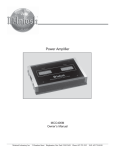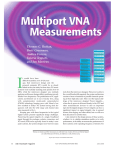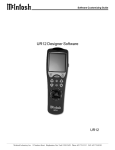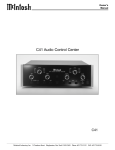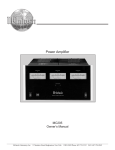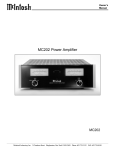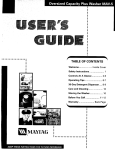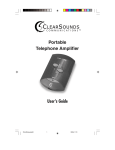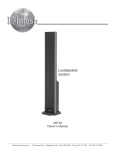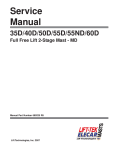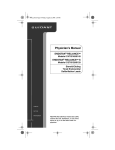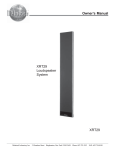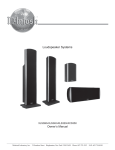Download McIntosh XRT30 Owner`s manual
Transcript
Owner’s Manual XRT30 Loudspeaker System XRT30 McIntosh Laboratory, Inc. 2 Chambers Street Binghamton, New York 13903-2699 Phone: 607-723-3512 FAX: 607-724-0549 WARNING - TO REDUCE RISK OF FIRE OR ELECTRICAL SHOCK, DO NOT EXPOSE THIS EQUIPMENT TO RAIN OR MOISTURE. NO USER-SERVICEABLE PARTS INSIDE. REFER SERVICING TO QUALIFIED PERSONNEL. IMPORTANT SAFETY INSTRUCTIONS! PLEASE READ THEM BEFORE OPERATING THIS EQUIPMENT. General: 1. Read these instructions. 2. Keep these instructions. 3. Heed all warnings. 4. Follow all instructions. 5. Warning: To reduce risk of fire or electrical shock, do not expose this equipment to rain or moisture. This unit is capable of producing high sound pressure levels. Continued exposure to high sound pressure levels can cause permanent hearing impairment or loss. User caution is advised and ear protection is recommended when playing at high volumes. 6. Only use attachments/accessories specified by the manufacturer. Installation: 7. Install in accordance with the manufacturer’s instructions. 8. Do not install near any heat sources such as radiators, heat registers, stoves, or other equipment (including amplifiers) that produce heat. 9. Do not use this equipment near water. 10. Do not expose this equipment to dripping or splashing and ensure that no objects filled with liquids, such as vases, are placed on the equipment. 11. Use only with the cart, stand, tripod, bracket, or table specified by the manufacturer, or sold with the equipment. When a cart is used, use caution when moving the cart/equipment combination to avoid injury from tip-over. 2 Care of Equipment: 12. Clean only with a dry cloth. 13. Do not permit objects or liquids of any kind to be pushed, spilled and/or fall into the equipment through enclosure openings. Repair of Equipment: 14. Refer all servicing to qualified service personnel. Servicing is required when the equipment has been damaged in any way, liquid has been spilled or objects have fallen into the equipment, the equipment has been exposed to rain or moisture, does not operate normally, or has been dropped. 15. Do not attempt to service beyond that described in the operating instructions. All other service should be referred to qualified service personnel. 16. When replacement parts are required, be sure the service technician has used replacement parts specified by McIntosh or have the same characteristics as the original part. Unauthorized substitutions may result in fire, electric shock, or other hazards. 17. Upon completion of any service or repairs to this product, ask the service technician to perform safety checks to determine that the product is in proper operating condition. Thank You Table of Contents Your decision to own this McIntosh XRT30 Loudspeaker System ranks you at the very top among discriminating music listeners. You now have “The Best.” The McIntosh dedication to “Quality,” is assurance that you will receive many years of musical enjoyment from this unit. Please take a short time to read the information in this manual. We want you to be as familiar as possible with all the features and functions of your new McIntosh. Safety Instructions ............................................................. 2 Thank You and Please Take a Moment ............................. 3 Technical Assistance and Customer Service ..................... 3 Table of Contents and Important Information ................... 3 Introduction ....................................................................... 4 Performance Features ........................................................ 5 Dimensions ........................................................................ 6 Installation ....................................................................... 10 How to Connect using a single amplifier ........................ 12 How to Connect using two amplifiers ............................. 14 How to Connect using three amplifiers ........................... 16 Specifications .................................................................. 18 Packing Instruction .......................................................... 19 Please Take A Moment The serial number, purchase date and McIntosh Dealer name are important to you for possible insurance claim or future service. The spaces below have been provided for you to record that information: Serial Number: Purchase Date: Dealer Name: Technical Assistance If at any time you have questions about your McIntosh product, contact your McIntosh Dealer who is familiar with your McIntosh equipment and any other brands that may be part of your system. If you or your Dealer wish additional help concerning a suspected problem, you can receive technical assistance for all McIntosh products at: McIntosh Laboratory, Inc. 2 Chambers Street Binghamton, New York 13903 Phone: 607-723-1545 Fax: 607-723-3636 Customer Service If it is determined that your McIntosh product is in need of repair, you can return it to your Dealer. You can also return it to the McIntosh Laboratory Service Department. For assistance on factory repair return procedure, contact the McIntosh Service Department at: McIntosh Laboratory, Inc. 2 Chambers Street Binghamton, New York 13903 Phone: 607-723-3515 Fax: 607-723-1917 Copyright 2002 by McIntosh Laboratory, Inc. Important Information Caution: The XRT30 Bass Section Cabinet weight is 192 pounds (87.1kg) and the High Frequency Column weight is 82 pounds (37.20kg) net. It requires two or more persons to safely handle each section. 1. It is very important that Loudspeaker Cables of adequate size be used, to ensure that there will be no power loss or heating. Cable size is specified in Gauge numbers or AWG (American Wire Gauge). The smaller the Gauge number, the larger the wire size: If the Loudspeaker Cables are 25 feet (7.62m) or less, use at least 18 Gauge (AWG) wire size or larger. If the Loudspeaker Cables are 50 feet (38.1m) or less, use at least 14 Gauge (AWG) wire size or larger. If the Loudspeaker Cables are 100 feet (76.2m) or less, use at least 12 Gauge (AWG) wire size or larger. The Loudspeaker Connection Terminals can accept up to 12 Gauge (AWG) wire. 2. For additional connection information, refer to the owner’s manual(s) for any component(s) connected to the XRT30 Loudspeaker. 3. The XRT30 has built-in speaker protection in the form of six automatic resetting solid-state devices as part of the crossover networks. Two protect the tweeters, one for the midranges and three for the woofers. The characteristics of this protection are that a certain amount of overdrive is allowed but extended periods of overdrive will trigger protection. If an obvious lack of high, mid or low frequencies is noticed, the Loudspeaker Protection Device may have activated. The protection devices will automatically reset when the volume control is reduced significantly and kept low until the output of the affected Loudspeaker Element returns to normal. 4. When the XRT30 Loudspeaker System is driven by more than one amplifier, the output levels of the different amplifiers connected to the Loudspeaker System must be adjusted to achieve a proper balance between the low, midrange and high frequencies reproduced. This adjustment is best achieved through the use of audio test equipment operated by a qualified installer. 3 Introduction McIntosh Acoustic Engineers have refined the line source Column Loudspeaker concept to provide superior quality midrange and high frequency sound reproduction in a full range system. The High Frequency Section utilizes a patented Column Design1 with multiple four inch Midrange LD/HP2 Magnetic Circuit Design Figure 1 Drivers and one inch soft dome Tweeters. Refer to figure 1. Since the audio power fed to a column is distributed among all the drivers, each driver does not have to work as hard, resulting in greater power handling capability and a dramatic reduction in distortion. The Sound Waves from the Column produce a Cylindrical Wave Front with a stable symmetrical horizontal sound dispersion to minimize undesirable floor and ceiling reflections that could detract from a stable sound image. Refer to figure 2. In the illusFigure 2 tration the Loudspeaker on the left side produces a Cylindrical Wave Front and the Loudspeaker on the right side produces a conventional Spherical Wave Front. The Low Frequency Section of the System consists of two 12 inch Woofers. They have a large magnet assembly and long cone excursions with very low levels of harmonic distortion and frequency response down to 16Hz. Refer to figFigure 3 1 COLUMN Pat. No. 4,267,405 4 2 LD/HP Pat. No. 5,151,943 ure 3. The Woofer also incorLD/HP porates McIntosh’s Patented Conventional LD/HP2 Magnetic Circuit Design with shielding to greatly reduce any external magnetic field. Extensive investigating and testing resulted in a new design concept which utilizes a pair of aluminum shorting Figure 4 sleeves in the magnetic circuit. Refer to figure 4. The sleeves virtually eliminate the negative influence of the fluctuating voice coil field on the permanent magnet field. This results in lower distortion due to more linear magnetic flux in the voice coil gap. Refer to figure 5. Additional benefits are less volume compression due to imFigure 5 proved heat transfer through the sleeves and a cooler operating voice coil. Both measurements, as well as critical listening, reveal ten times less distortion than previous designs. A good example of this low distortion is incredible smoothness and clarity in the reproduction of the human voice. The Crossover Networks used in the XRT30 Loudspeaker System are designed to ensure an even frequency response over the entire audible range. The Low Frequency Crossover Network is a Third Order design utilizing Capacitors and Inductors with Figure 6 high current capacity. Refer to figure 6. There are three different types of low loss (DCR) Inductors in the network, each one chosen not to exhibit any core saturation even at high power Introduction and Performance Features Performance Features levels. This prevents the addition of distortion to the music at low frequencies. The High Frequency Crossover Network utilizes both Second and Third Order Crossover Designs. Refer to figure 7. It also uses Capacitors and Inductors with high current capacity. The Capacitors used include low loss (ESR) Polypropylene and Mylar types. Both Crossover Networks also utilize self resetting Figure 7 high current PolySwitches to provide an extra measure of protection. The enclosures are an important part of the XRT30 Loudspeaker System. The Bass Section Cabinet is constructed from 1 inch and 1-1/2 inch thick MDF with laminated hardwoods and veneers. Internally, the cabinet is reinforced with multiple MDF Cross-Bracing Trusses all designed to help insure that the cabinet will not vibrate. Refer to figure 8. The High Frequency Column Section utilizes a Figure 8 massive extruded aluminum enclosure that houses the 30 four inch Midrange and 25 one inch Tweeter Drivers. Refer to figure 9. It also has multiple front to back internal braces to form a dampened rigid Column Structure. The Figure 9 Column’s small footprint allows for a variety of different placements in a room. • Patented LD/HP Technology The McIntosh Low Frequency and Midrange Loudspeaker Elements feature the patented LD/HP Magnetic Circuit Design. This design, when compared to conventional Loudspeaker Elements, reduces distortion significantly. It also increases power handling and efficiency. • Neodymium-Iron-Boron Alloy Magnets The 30 four inch Midranges and 25 one inch Dome Tweeters all use this Alloy. The Neodymium-Iron-Boron Alloy has a high flux density per unit of volume and helps to keep the Column weight to a minimum. • Shielded Magnetic Field The XRT30 may be used in Home Theater Installations near a television receiver or monitor without causing the television image to degrade. McIntosh has designed special shielding around the magnetic structure of the XRT30 Loudspeaker Elements to prevent interference. • High Power Handling The Loudspeaker Elements and Crossover Components of the XRT30 are all chosen for use with powerful amplifiers up to 1,200 watts. • Superior Imaging Locating the Column of Tweeters between the two Columns of Midranges helps to generate a symmetrical horizontal polar response for superior imaging. • Versatile Operation and Placement In additional to the regular connections, the XRT30 Loudspeaker System provides separate connections for Bi-Amplification and Tri-Amplification hookups. The Crossover Network has provisions to ensure the best performance when the High Frequency Column is mounted in a wall. • Gold Plated Input Connectors The XRT30 input connectors are gold plated for superior corrosion resistance and high electrical conductivity. 5 XRT30 Bass Section Dimensions Top View of the XRT30 Bass Section The following dimensions can assist in determining the best location for your XRT30 Loudspeaker System. 17" 43.18cm 17" 14" 43.18cm 35.56cm 14" 35.56cm 1" 2.54cm Side View of the XRT30 Bass Section Front View of the XRT30 Bass Section 14-7/8" 37.78cm 17" 43.18cm 37-3/4" 95.88cm 31-15/16" 37-1/2" 81.12cm 95.25cm 1-3/4" 4.45cm 14-7/8" 37.78cm 1-5/8" 4.13cm 18-5/8" 47.31cm 6 20-1/4" 51.44cm Dimensions Rear View of the XRT30 Bass Section Front View of the XRT30 Bass Section 19-1/4" 48.90cm 21-1/4" 53.98cm 16-1/2" 41.91cm 14-1/4" 36.20cm 11-3/4" 29.85cm 7-13/16" 19.84cm 10-1/8" 25.72cm 10-1/8" 25.72cm 12-15/32" 31.67cm 7 XRT30 Column Section Dimensions The following dimensions can assist in determining the best location for your XRT30 Loudspeaker System. Side View of the XRT30 High Frequency Column Front View of the XRT30 High Frequency Column Rear View of the XRT30 High Frequency Column 4-1/2" 11.43cm 5-3/8" 13.65cm 76-1/8" 193.36cm 21-15/16" 3-15/16" 55.72cm 10.00cm 17-1/4" 43.82cm 1-3/4" 4.45cm 16-3/8" 41.59cm 12-1/2" 31.75cm 5-3/8" 13.65cm 5-3/4" 14.61cm 5-7/8" 14.92cm 16-3/8" 41.59cm 8-3/16" 20.80cm 10-9/16" 26.83cm 8 Dimensions End View and Base of the XRT30 High Frequency Column Front View of the XRT30 High Frequency Column 9-5/8" 24.45cm 13-1/16" 33.18cm 6-1/2" 16.51cm 3-3/8" 8.57cm 9-3/16" 23.34cm 7/8" 2.22cm 1-3/8" 3.49cm 4-1/2" 11.43cm 2-1/8" 5.40cm 1-5/8" 4.13cm 7" 17.78cm 13-1/8" 33.34cm 4-1/2" 11.43cm 11-1/16" 28.10cm 2-3/4" 6.99cm 9-3/4" 24.77cm 9" 22.86cm 16-3/8" 41.59cm 9 Installation The XRT30 High Frequency Column Section requires two or more persons to safely handle the Column during assembly and placement. Follow the instructions below for unpacking and assembly. It is recommended that the Professionals at your McIntosh Dealer, who are skilled in all aspects of installation and operation, install the XRT30 Loudspeaker System and any associated audio equipment. Unpacking the High Frequency Column 1. Remove the banding material from the shipping carton. Refer to figure 10. 2. Lift off the top of the shipping carton and set it aside. 3. Lift up on the rear of the Column Loudspeaker, near the foam Figure 10 packing material at both ends. Place the entire assembly (Column, Loudspeaker Grille and foam packing material) next to the bottom shipping carton on a flat surface. Refer to figure 11. 4. Release the Loudspeaker Grille from the packing material by opening the slit in the Figure 11 packing material located on the top center. Remove the Loudspeaker Grille from the protective shipping wrap and set it aside. 5. In a similar manner, lift out the Loudspeaker Column and set it aside. 6. Replace the shipping carton top onto the shipping carton bottom. Take the two center pieces of the just removed packing material and lay it down flat onto the top of the shipping carton. 7. Carefully remove the protective shipping bag(s) from the Loudspeaker Column so as not to mar the Column Finish or damage the Loudspeaker Drivers. 8. Place the Loudspeaker Column on top of the packing material located on top of the shipping carton making sure to align the Column Bottom End (the Glass Name Plate end) to the end of the shipping carton. Refer to figure 12. Unpacking the Column Base 9. Lift and remove the bubble wrap packing material from the base. 10. Locate and remove the bag of hardware and Allen Wrench Tool taped to the bottom of the base. Assembling the High Frequency Column 11. Using the supplied Allen Wrench, remove two screws Remove from each side of Remove Two Screws Two Screws the Column Bottom. Refer to figure 14. 12. Orient the Column Base with the Decal Arrow pointing toward the front of the Loudspeaker ColFigure 14 umn. Refer to figure 15. Glass Panel Packing material Packing material Figure 12 Fastening Pin Gromment Figure 13 10 Installation 13. Attach the Column Base to the Loudspeaker Column using the four supplied machine bolts and washers. Refer to figure 12. 14. Orient the Loudspeaker Grille with the extended wood trim pointed towards the Column Base and line it up even with top/sides of the Column. Align the Grille fastening pins to the Column Grommets (there are six pins on Figure 15 each side). Carefully push down to secure the Grille to the Column. Refer to figure 13. Optional Feet 15. Two sets of optional feet (fourteen Tiptoes and fourteen Glides) are supplied with the XRT30 Loudspeaker System. Refer to figure 16. To prevent crushing carpet use the Tiptoe Spikes; to protect non-carpeted flooring use the Chrome Glides. Both the Glides and Tiptoes have a Glides Tiptoes threaded shaft and locking nut Figure 16 that screw into the tapped holes in the bottom of the XRT30’s base rails. The feet can be independently adjusted to compensate for uneven flooring. The second set of optional feet are for the Bass Section Cabinet. 16. Stand the Column upright. Room Placement Loudspeaker placement in a room can greatly affect performance. The XRT30 Loudspeaker is designed for both Music and Home Theater Systems. The optimal method for selecting speaker locations includes the use of a real time spectrum analyzer operated by an experienced system installer. An uncompromising installation would take into consideration the floor, wall and ceiling coverings, the type and placement of furniture and can even include the architectural design of the room and its construction materials. In those instances where placement in the room is fixed an enviromental equalizer may be needed to restore proper musical balance. Placement near a wall, corner, floor, ceiling or any intersecting surfaces will reinforce some bass frequencies. Which bass frequencies are boosted by placement in a particular location is dependant on the dimensions of the room. Test the various Loudspeaker locations by playing music with continuous bass, setting up the speakers and listening to them from the main listening spot. Move the Loudspeakers to an alternate location and repeat the listening, paying attention to how the bass qualities and response levels change. Do not assume the loudest bass is best; rather listen for booming (a lack of articulation), as well as a balance over the whole spectrum, to assure the bass will not drown out the other parts of the music. Experiment with various Loudspeaker positions until the locations that sound best are found. Locating Loudspeakers for use in Home Theater In a Home Theater application, the placement of Left and Right Front Loudspeakers can be limited by such considerations as the size and location of the video monitor. The locating suggestions in the “for use in a Music System” section below can still be Figure 17 helpful as a starting place. Refer to figure 17. Locating Loudspeakers for use in a Music System When used in a Music System the distance between the Loudspeakers and the listener to the Loudspeakers should form an isosceles triangle. If the speakers are too far apart relative to the listener, some imaging can be lost. Refer to figure 18. Figure 18 11 How to Prepare Hookup Cables The McIntosh XRT30 Loudspeaker System utilizes binding posts for speaker wire connections. Prepare the Loudspeaker Hookup Cables that attach to the Power Amplifier Output Terminals: Bare wire cable ends: Carefully remove sufficient insulation from the cable ends, refer to figures 20, 21 & 22. If the cable is stranded, carefully twist the strands together as tightly as possible. Note: If desired, the twisted ends can be tinned with solder to keep the strands together and/or attach a spade lug. Spade lug or prepared wire connection: Insert the spade lug connector or prepared section of the cable end into the terminal side access hole, and tighten the terminal cap until the cable is firmly clamped into the terminal so the wires cannot slip out. Refer to figures 23, 24 & 25. How to Connect using a single Amplifier 1. Connect a Loudspeaker cable from the Negative (-) Binding Post of the Amplifier to the XRT30 Bass Section SYSTEM INPUT COMmon (-) Binding Post. Note: The SYSTEM INPUT AND WOOFER DIRECT COMmon (-) Binding Posts on the XRT30 Bass Section must have a jumper installed between them. 2. Connect a Loudspeaker cable from the Positive (+) Binding Post of the Amplifier to the XRT30 Bass Section SYSTEM INPUT 4S (+) Binding Post. 3. Connect a Loudspeaker cable from the TO COLUMN MID/HIGH COMmon (-) Binding Post of the XRT30 Bass Section to the Column MID COMmon (-) Binding Post of the High Frequency Column Section. Note: The MID and HIGH COMmon (-) Binding Posts must have a jumper installed between them. Likewise the MID and HIGH 4S (+) Binding Posts must also have a jumper installed between them. If the XRT30 Column is install into wall, use the MID IN-WALL Binding Posts instead of the Column MID Binding Posts. 4. Connect a Loudspeaker cable from the TO COLUMN MID/HIGH 4S (+) Binding Post of the XRT30 Bass 12 Section to the COLUMN MID 4S (+) Binding Post of the High Frequency Column Section.. 5. Tighten all of the Loudspeaker and Amplifier Binding Posts. McIntosh Single Channel Amplifier How to Connect using a single Amplifier XRT30 High Frequency Column Section XRT30 Low Frequency Bass Section 13 How to Prepare Hookup Cables The McIntosh XRT30 Loudspeaker System utilizes binding posts for speaker wire connections. Prepare the Loudspeaker Hookup Cables that attach to the Power Amplifier Output Terminals: Bare wire cable ends: Carefully remove sufficient insulation from the cable ends, refer to figures 20, 21 & 22. If the cable is stranded, carefully twist the strands together as tightly as possible. Note: If desired, the twisted ends can be tinned with solder to keep the strands together and/or attach a spade lug. Spade lug or prepared wire connection: Insert the spade lug connector or prepared section of the cable end into the terminal side access hole, and tighten the terminal cap until the cable is firmly clamped into the terminal so the wires cannot slip out. Refer to figures 23, 24 & 25. Binding Post of the Amplifier Number Two to the XRT30 High Frequency Column Section MID COMmon (-) Binding Post. 4. Connect a Loudspeaker cable from the Positive (+) Binding Post of the Amplifier Number Two to the XRT30 High Frequency Column Section MID 4S (+) Binding Post. Note: The MID and HIGH COMmon (-) Binding Posts must have a jumper installed between them. Likewise the MID and HIGH 4S (+) Binding Posts must also have a jumper installed between them. If the XRT30 Column is installed into wall, use the MID IN-WALL Binding Posts instead of the Column MID Binding Posts. 5. Tighten all of the Loudspeaker and Amplifier Binding Posts. McIntosh Single Channel Amplifier Number Two How to Connect using two Amplifiers 1. Connect a Loudspeaker cable from the Negative (-) Binding Post of the Amplifier Number One to the XRT30 Bass Section SYSTEM INPUT COMmon (-) Binding Post. Note: The SYSTEM INPUT AND WOOFER DIRECT COMmon (-) Binding Posts on the XRT30 Bass Section must have a jumper installed between them. If the Audio or Home Theater System Electronics has the capability of an Electronic Crossover set to 80Hz, remove the jumper between the SYSTEM INPUT AND WOOFER DIRECT COMmon (-) Binding Posts on the XRT30 Bass Section and save them for possible future use. Connect the Amplifier that is reproducing the frequency range from 16Hz to 80Hz to the WOOFER DIRECT Binding Posts, instead of the SYSTEM INPUT Binding Posts. 2. Connect a Loudspeaker cable from the Positive (+) Binding Post of the Amplifier Number One to the XRT30 Bass Section SYSTEM INPUT 4S (+) Binding Post. 3. Connect a Loudspeaker cable from the Negative (-) 14 McIntosh Single Channel Amplifier Number One How to Connect using two Amplifiers XRT30 High Frequency Column Section XRT30 Low Frequency Bass Section 15 How to Prepare Hookup Cables The McIntosh XRT30 Loudspeaker System utilizes binding posts for speaker wire connections. Prepare the Loudspeaker Hookup Cables that attach to the Power Amplifier Output Terminals: Bare wire cable ends: Carefully remove sufficient insulation from the cable ends, refer to figures 20, 21 & 22. If the cable is stranded, carefully twist the strands together as tightly as possible. Note: If desired, the twisted ends can be tinned with solder to keep the strands together and/or attach a spade lug. Spade lug or prepared wire connection: Insert the spade lug connector or prepared section of the cable end into the terminal side access hole, and tighten the terminal cap until the cable is firmly clamped into the terminal so the wires cannot slip out. Refer to figures 23, 24 & 25. Section and save them for possible future use. 4. Connect a Loudspeaker cable from the Negative (-) Binding Post of the Amplifier Number Two to the XRT30 High Frequency Column Section MID COMmon (-) Binding Post. 5. Connect a Loudspeaker cable from the Positive (+) Binding Post of the Amplifier Number Two to the XRT30 High Frequency Column Section MID 4S (+) Binding Post. 6. Connect a Loudspeaker cable from the Negative (-) Binding Post of the Amplifier Number Three to the XRT30 High Frequency Column Section HIGH COMmon (-) Binding Post. 7. Connect a Loudspeaker cable from the Positive (+) Binding Post of the Amplifier Number Three to the XRT30 High Frequency Column Section HIGH 4S (+) Binding Post. 8. Tighten all of the Loudspeaker and Amplifier Binding Posts. McIntosh Single Channel Amplifier Number Two How to Connect using three Amplifiers 1. Connect a Loudspeaker cable from the Negative (-) Binding Post of the Amplifier Number One to the XRT30 Bass Section SYSTEM INPUT COMmon (-) Binding Post. Note: The SYSTEM INPUT AND WOOFER DIRECT COMmon (-) Binding Posts on the XRT30 Bass Section must have a jumper installed between them. If the Audio or Home Theater System Electronics has the capablilty of a Electronic Crossover set to 80Hz, remove the jumper between the SYSTEM INPUT AND WOOFER DIRECT COMmon (-) Binding Posts on the XRT30 Bass Section and save it for possible future use. Connect the Amplifier that is reproducing the frequency range from 20Hz to 80Hz to the WOOFER DIRECT Binding Posts, instead of the SYSTEM INPUT Binding Posts. 2. Connect a Loudspeaker cable from the Positive (+) Binding Post of the Amplifier Number One to the XRT30 Bass Section SYSTEM INPUT 4S (+) Binding Post. 3. Remove the jumpers from between the MID and HIGH Binding Posts on the XRT30 High Frequency Column 16 McIntosh Single Channel Amplifier Number One How to Connect using three Amplifiers XRT30 High Frequency Column Section McIntosh Single Channel Amplifier Number Three XRT30 Low Frequency Bass Section 17 Specifications Specifications System Driver Complement Two 12 inch Woofers Thirty 4 inch Midranges Twenty-five 1 inch Dome Tweeters Impedance 4 ohms Nominal Frequency Response 16Hz - 20kHz Sensitivity 88dB (2.8V/1m) Crossover Frequencies 80Hz 1,700Hz Power Handling 1200 Watts Maximum Overall Dimensions Base Section: 37-3/4 inches (95.88cm) Height, 20-1/4 inches (51.44cm) Width, 18-5/8 inches (47.31cm) Depth Column Section(including attached base): 76-1/8 inches (193.36cm) Height, 16-3/8 inches (41.59cm) Width, 16-3/8 inches (41.59cm) Depth Finish Black Ash, Natural Cherry, Red Cherry Weight (each) Base Section: 192 pounds (87.1kg) net, 212 pounds (96.16kg) in shipping carton Column Section: 82 pounds (37.20kg) net, 102 pounds (46.27kg) in shipping carton Column Base: 15.5 pounds (7.03kg) net, 18 pounds (8.16kg) in shipping carton 18 Packing Instructions Packing Instructions In the event it is necessary to repack the equipment for shipment, the equipment must be packed exactly as received. Failure to do so will result in shipping damage. Use the original shipping carton and interior parts only if they are in good serviceable condition. If a shipping carton or any of the interior part(s) are needed, please call or write Customer Service Department of McIntosh Laboratory. Note: The High Frequency Column Base is wrapped in bubble pack and placed in a small carton. High Frequency Section Column Quantity Part Number Description 1 034203 Top shipping carton 1 034204 Bottom shipping carton 2 034205 Foam end cap 2 034206 Foam center cap Bass Section Quantity Part Number 2 034218 2 034217 2 034220 Description Top or bottom shipping carton U-Shaped shipping carton Foam end cap Note: The Foam End Cap, when used for the bottom of the XRT30 Bass Section, has three foam knockouts which must be removed to accommodate the sides and front of the cabinet bottom. 19 McIntosh Laboratory, Inc. 2 Chambers Street Binghamton, NY 13903 McIntosh Part No. 040813




















